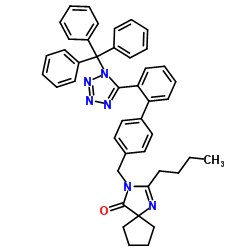Irbesartan

Irbesartan structure
|
Common Name | Irbesartan | ||
|---|---|---|---|---|
| CAS Number | 138402-11-6 | Molecular Weight | 428.529 | |
| Density | 1.3±0.1 g/cm3 | Boiling Point | 648.6±65.0 °C at 760 mmHg | |
| Molecular Formula | C25H28N6O | Melting Point | 180-181°C | |
| MSDS | Chinese USA | Flash Point | 346.0±34.3 °C | |
Use of IrbesartanIrbesartan is a highly potent and specific angiotensin II type 1 (AT1) receptor antagonist with IC50 of 1.3 nM.Target: Angiotensin ReceptorIrbesartan treatment markedly induces the expression of the adipogenic marker gene adipose protein 2 (aP2) in 3T3-L1 cells in a concentration-dependent manner with EC50 of 3.5 μM and 3.3-fold induction at the concentration of 10 μM. Irbesartan (10 μM) markedly induces transcriptional activity of the peroxisome proliferator–activated receptor-γ (PPARγ) by 3.4-fold independent of its AT1 receptor blocking action. Pretreatment with Irbesartan (~10 μM) decreases angiotensin II-induced apoptosis in rat vascular smooth muscle cells by blocking angiotensin II internalization in a concentrationdependent manner. Oral administration of Irbesartan (1 mg/kg) reduces angiotensin II (AII)-induced hypertension, equipotent with losartan in conscious normotensive rats, markedly more active than losartan (10 mg/kg) in normotensive cynomolgus monkeys. Administration of Irbesartan (7 mg/kg/day) significantly prevents skeletal muscle apoptosis and muscle atrophy in rats with monocrotaline-induced congestive heart failure (CHF), which is involved with the decrease of TNFα level and attributed to AT1 receptor blocking. |
| Name | irbesartan |
|---|---|
| Synonym | More Synonyms |
| Description | Irbesartan is a highly potent and specific angiotensin II type 1 (AT1) receptor antagonist with IC50 of 1.3 nM.Target: Angiotensin ReceptorIrbesartan treatment markedly induces the expression of the adipogenic marker gene adipose protein 2 (aP2) in 3T3-L1 cells in a concentration-dependent manner with EC50 of 3.5 μM and 3.3-fold induction at the concentration of 10 μM. Irbesartan (10 μM) markedly induces transcriptional activity of the peroxisome proliferator–activated receptor-γ (PPARγ) by 3.4-fold independent of its AT1 receptor blocking action. Pretreatment with Irbesartan (~10 μM) decreases angiotensin II-induced apoptosis in rat vascular smooth muscle cells by blocking angiotensin II internalization in a concentrationdependent manner. Oral administration of Irbesartan (1 mg/kg) reduces angiotensin II (AII)-induced hypertension, equipotent with losartan in conscious normotensive rats, markedly more active than losartan (10 mg/kg) in normotensive cynomolgus monkeys. Administration of Irbesartan (7 mg/kg/day) significantly prevents skeletal muscle apoptosis and muscle atrophy in rats with monocrotaline-induced congestive heart failure (CHF), which is involved with the decrease of TNFα level and attributed to AT1 receptor blocking. |
|---|---|
| Related Catalog | |
| References |
| Density | 1.3±0.1 g/cm3 |
|---|---|
| Boiling Point | 648.6±65.0 °C at 760 mmHg |
| Melting Point | 180-181°C |
| Molecular Formula | C25H28N6O |
| Molecular Weight | 428.529 |
| Flash Point | 346.0±34.3 °C |
| Exact Mass | 428.232452 |
| PSA | 87.13000 |
| LogP | 4.51 |
| Vapour Pressure | 0.0±1.9 mmHg at 25°C |
| Index of Refraction | 1.690 |
| Storage condition | -20°C Freezer |
| Hazard Codes | Xn: Harmful; |
|---|---|
| Risk Phrases | R22 |
| Safety Phrases | S26-S36/37/39 |
| RIDADR | 3276 |
| Packaging Group | III |
| Hazard Class | 6.1 |
| HS Code | 2933990090 |
| Precursor 8 | |
|---|---|
| DownStream 1 | |
| HS Code | 2933990090 |
|---|---|
| Summary | 2933990090. heterocyclic compounds with nitrogen hetero-atom(s) only. VAT:17.0%. Tax rebate rate:13.0%. . MFN tariff:6.5%. General tariff:20.0% |
|
[Irbesartan in clinical practice].
Kardiologiia 52(11) , 66-74, (2012) Irbesartan is a noncompetitive angiotensin II receptor type 1 antagonist which has been successfully used for more than 10 years for the treatment of hypertensive disease. In a dose of 150-300 mg/day ... |
|
|
Systemic sclerosis immunoglobulin induces growth and a pro-fibrotic state in vascular smooth muscle cells through the epidermal growth factor receptor.
PLoS ONE 9(6) , e100035, (2014) It has been suggested that autoantibodies in systemic sclerosis (SSc) may induce the differentiation of cultured fibroblasts into myofibroblasts through platelet-derived growth factor receptor (PDGFR)... |
|
|
Optimum AT1 receptor-neprilysin inhibition has superior cardioprotective effects compared with AT1 receptor blockade alone in hypertensive rats.
Kidney Int. 88 , 109-20, (2015) Neprilysin inhibitors prevent the breakdown of bradykinin and natriuretic peptides, promoting vasodilation and natriuresis. However, they also increase angiotensin II and endothelin-1. Here we studied... |
| 2-Butyl-3-{[2'-(1H-tetrazol-5-yl)-4-biphenylyl]methyl}-1,3-diazaspiro[4.4]non-1-en-4-one |
| Irbesartan |
| MFCD00864464 |
| 3-((2'-(1H-Tetrazol-5-yl)-[1,1'-biphenyl]-4-yl)methyl)-2-butyl-1,3-diazaspiro[4.4]non-1-en-4-one |
| 3-Butyl-2-[[4-[2-(2H-tetrazol-5-yl)phenyl]phenyl]methyl]-2,4-diazaspiro[4.4]non-3-en-1-one |
| 1,3-Diazaspiro[4.4]non-1-en-4-one, 2-butyl-3-[[2'-(1H-tetrazol-5-yl)[1,1'-biphenyl]-4-yl]methyl]- |
| 2-Butyl-3-[[2'-(2H-tetrazol-5-yl)[1,1'-biphenyl]-4-yl]methyl]-1,3-diazaspiro[4.4]non-1-en-4-one |
| 2-Butyl-3-(p-(o-1H-tetrazol-5-ylphenyl)benzyl)-1,3-diazaspiro[4.4]non-1-en-4-one |
| 1,3-diazaspiro4.4non-1-en-4-one, 2-butyl-3-2'-(1H-tetrazol-5-yl)1,1'-biphenyl-4-ylmethyl- |
| 2-butyl-3-{[2'-(1H-tetrazol-5-yl)biphenyl-4-yl]methyl}-1,3-diazaspiro[4.4]non-1-en-4-one |
| Avapro |
![3-[2'-(1H-tetrazol-5-yl)-biphenyl-4-ylmethyl]-2-thiophen-2-yl-1,3-diaza-spiro[4.4]non-1-en-4-one Structure](https://image.chemsrc.com/caspic/022/1199814-92-0.png) CAS#:1199814-92-0
CAS#:1199814-92-0![4'-[(2-Butyl-4-oxo-1,3-diazaspiro[4.4]non-1-en-3-yl)methyl]-[1,1'-Biphenyl]-2-carbonitrile Structure](https://image.chemsrc.com/caspic/091/138401-24-8.png) CAS#:138401-24-8
CAS#:138401-24-8 CAS#:138402-10-5
CAS#:138402-10-5![N-[(2'-Cyano[1,1'-biphenyl]-4-yl)methyl]-1-[(1-oxopentyl)amino]cyclopentanecarboxamide Structure](https://image.chemsrc.com/caspic/247/141745-71-3.png) CAS#:141745-71-3
CAS#:141745-71-3![2-butyl-3-{2'-[2-(1-methyl-1-phenyl-ethyl)-2H-tetrazol-5-yl]-biphenyl-4-ylmethyl}-1,3-diaza-spiro[4.4]non-1-en-4-one Structure](https://image.chemsrc.com/caspic/426/852357-70-1.png) CAS#:852357-70-1
CAS#:852357-70-1![3-[4-bromobenzyl]-2-n-butyl-1,3-diazaspiro[4.4]non-1-en-4-one Structure](https://image.chemsrc.com/caspic/231/731851-41-5.png) CAS#:731851-41-5
CAS#:731851-41-5![[2-[1-(TRIPHENYLMETHYL)-1H-TETRAZOL-5-YL]PHENYL]BORONIC ACID Structure](https://image.chemsrc.com/caspic/281/144873-97-2.png) CAS#:144873-97-2
CAS#:144873-97-2 CAS#:329055-23-4
CAS#:329055-23-4![5-[2-(4'-Methylbiphenyl)]tetrazole structure](https://image.chemsrc.com/caspic/124/120568-11-8.png) CAS#:120568-11-8
CAS#:120568-11-8